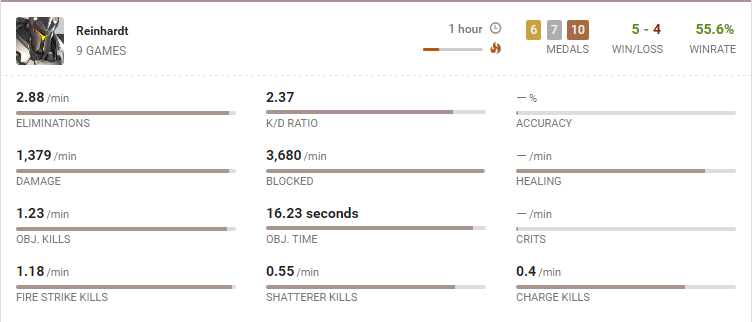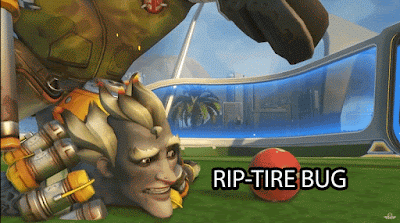
If you find yourself wondering why Ana seems to have had a recent surge in popularity in Competitive mode, the reason is most likely due to the NIP strat. If you've ever had team mates that asked the team to use three tanks and three supports, one of whom is Ana, you've come across people attempting to use the NIP strat.
However, while the strategy has proven effective at the pro level, it is unlikely to replace the current 2/2/2 meta team composition common in Competitive ranks under Master. Even if you know how it works, you'll want to think thrice about using it outside of a coordinated 6-stack team.
What is the NIP strat?
The NIP strat refers to a strategy created by pro Overwatch team Ninjas In Pajamas (NIP). Other names used to refer to it include 3/3 and tri-tank/tri-support.
NIP was the first team to realize the potential of Ana's Nano Boost ultimate in a tri-tank team composition, and successfully used it in tournaments. A team using their strategy will usually run a Reinhardt, Zarya and usually Roadhog, along with three supports. Two will usually be Ana and Lucio, with the third support toggling between Mercy or Zenyatta depending on the map and the other team's composition. Occasionally, the third support might be switched out for a DPS.
The entire strategy revolves around Ana and the use of her ultimate. Ana needs to build her ult charge extremely quickly by spamming heals on the tanks as they take damage. She should do it fast enough to get it before any other hero, then boost Reinhardt or Roadhog to create a hard to kill juggernaut that picks off the other team. This also has the effect of charging the ultimates of their teammates. Subsequently, each of the tanks in the team will have an ultimate up for every fight in addition to Ana's fast-charging ult, giving them a huge advantage.
Why you shouldn't use it in Competitive
The fact is that pro strategies and meta usually don't translate well to the uncoordinated play that makes up the majority of solo queue matches under Master rank. In fact, pro players will not recommend the NIP strat be used in Competitive mode outside of a coordinated 6 stack team that has practiced with it.
The tri-tank, tri-support composition depends a lot on ult tempo and coordination. Ana needs to be able to build her charge quickly, use her ult at the right time and communicate with her team. The tanks need to be able to cycle their ults on every fight.
Even beyond the advanced coordination needed, the tank who receives the boost will need to know how to use it. It's not uncommon for Gold tier Ana players to complain about boosting their team's Reinhardt, only for him to stand in the same spot with his shield up. It is also not rare to hear Ana's ultimate activate, only to see a nano-boosted Lucio or Mercy rounding the corner while frantically spamming their weapons.
In solo or small group queues, going for low teamwork comps is usually the superior option. Teams that can pull off simple ult combos like Zarya and Pharah or Ana and Reaper will usually gain the upper hand in the average player's games.
When should you use the NIP strat?
As mentioned, the NIP strat is highly effective, but only if the 6-stack is very coordinated. This requires a lot of practice together as a team.
Each player in the team will also need to know their characters well. This goes double for the Ana player. Boosting a tank at the wrong time results in little more than a waste of ults. Boosting a tank that doesn't have their ult up may lead to sub-optimal results, and the result might be that the team never really finds its rhythm.
However, while the strategy has proven effective at the pro level, it is unlikely to replace the current 2/2/2 meta team composition common in Competitive ranks under Master. Even if you know how it works, you'll want to think thrice about using it outside of a coordinated 6-stack team.
What is the NIP strat?
The NIP strat refers to a strategy created by pro Overwatch team Ninjas In Pajamas (NIP). Other names used to refer to it include 3/3 and tri-tank/tri-support.
NIP was the first team to realize the potential of Ana's Nano Boost ultimate in a tri-tank team composition, and successfully used it in tournaments. A team using their strategy will usually run a Reinhardt, Zarya and usually Roadhog, along with three supports. Two will usually be Ana and Lucio, with the third support toggling between Mercy or Zenyatta depending on the map and the other team's composition. Occasionally, the third support might be switched out for a DPS.
The entire strategy revolves around Ana and the use of her ultimate. Ana needs to build her ult charge extremely quickly by spamming heals on the tanks as they take damage. She should do it fast enough to get it before any other hero, then boost Reinhardt or Roadhog to create a hard to kill juggernaut that picks off the other team. This also has the effect of charging the ultimates of their teammates. Subsequently, each of the tanks in the team will have an ultimate up for every fight in addition to Ana's fast-charging ult, giving them a huge advantage.
Why you shouldn't use it in Competitive
The fact is that pro strategies and meta usually don't translate well to the uncoordinated play that makes up the majority of solo queue matches under Master rank. In fact, pro players will not recommend the NIP strat be used in Competitive mode outside of a coordinated 6 stack team that has practiced with it.
The tri-tank, tri-support composition depends a lot on ult tempo and coordination. Ana needs to be able to build her charge quickly, use her ult at the right time and communicate with her team. The tanks need to be able to cycle their ults on every fight.
Even beyond the advanced coordination needed, the tank who receives the boost will need to know how to use it. It's not uncommon for Gold tier Ana players to complain about boosting their team's Reinhardt, only for him to stand in the same spot with his shield up. It is also not rare to hear Ana's ultimate activate, only to see a nano-boosted Lucio or Mercy rounding the corner while frantically spamming their weapons.
In solo or small group queues, going for low teamwork comps is usually the superior option. Teams that can pull off simple ult combos like Zarya and Pharah or Ana and Reaper will usually gain the upper hand in the average player's games.
When should you use the NIP strat?
As mentioned, the NIP strat is highly effective, but only if the 6-stack is very coordinated. This requires a lot of practice together as a team.
Each player in the team will also need to know their characters well. This goes double for the Ana player. Boosting a tank at the wrong time results in little more than a waste of ults. Boosting a tank that doesn't have their ult up may lead to sub-optimal results, and the result might be that the team never really finds its rhythm.
Despite the difficulty of pulling it off, if your team can get it down, you just might find yourself steamrolling to victory.





























